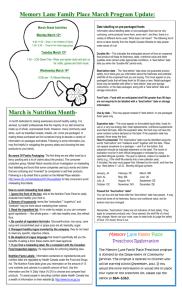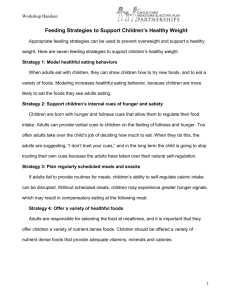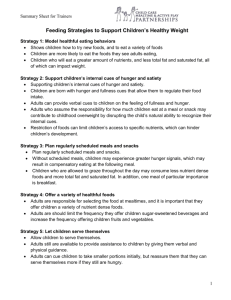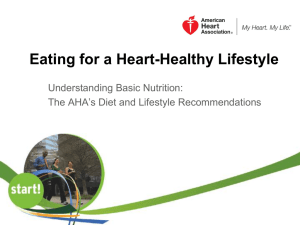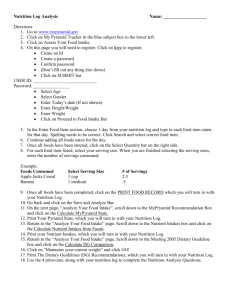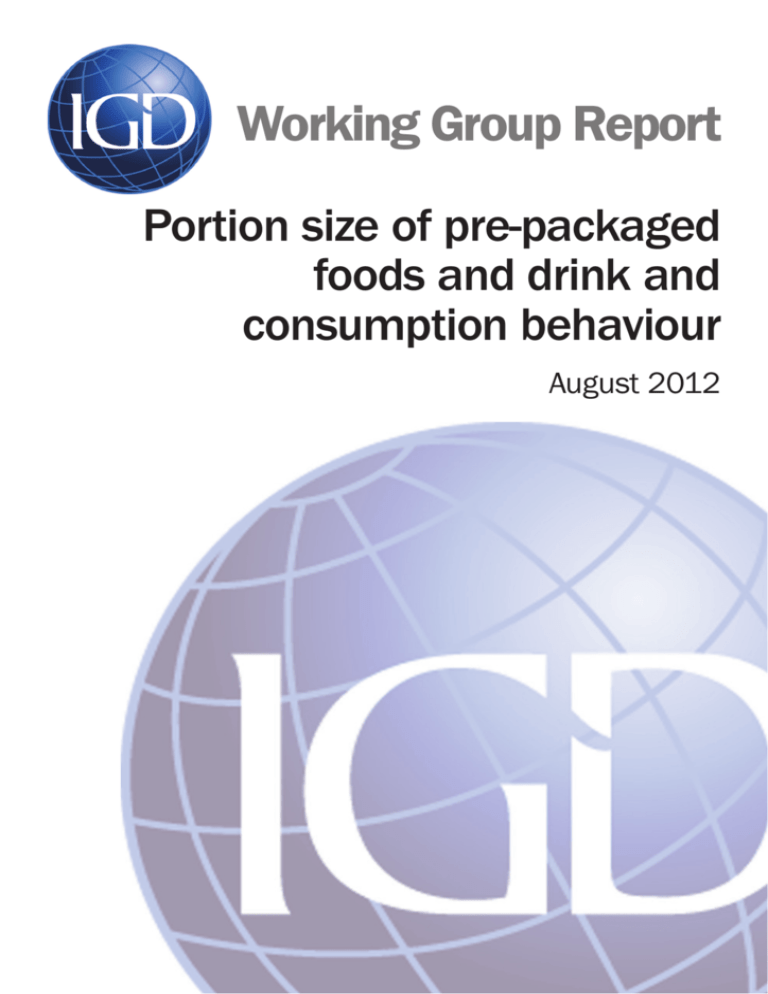
Working Group Report
Portion size of pre-packaged
foods and drink and
consumption behaviour
August 2012
© Institute
of Grocery Distribution 2012.
All intellectual property rights reserved.
IGD is the trade mark of the Institute of Grocery Distribution.
IGD authorises you to:
• View and print out the material for personal use only
• Extract small amounts of text, tables and charts for inclusion within internal company
documents for limited distribution. IGD must be referred to as the source of information when
this occurs
You are not authorised to:
• Sell, license or dispose of material for commercial or any other gain
• Alter the material in any way
Whilst every effort has been made to ensure that the information contained in this publication
is correct, neither IGD nor any of its staff shall be liable for errors or omissions howsoever
caused.
This publication is a guide only and does not provide specific advice on any specific product or
food area. You must seek your own independent legal advice or advice from nutrition experts
in all cases.
Portion size of pre-packaged foods and drink and consumption behaviour
Contents
Executive summary
1
1. Introduction
2
2. Purpose and scope of this report
3
3. Literature map of relevant research
3
4. Stakeholder workshop
8
5. Industry perspectives: Factors affecting the portion size of food and drink
10
5.1 Internal guidance and determining portion size
10
5.2 Technical aspects of portion size changes
10
5.3 Commercial aspects in changing portion size
11
5.4 Consumer insight and changing portion size
12
6. Discussion
14
7. Recommendations
15
Appendix 1. Additional cited research relating to non-pre-packaged food
16
Appendix 2. List of participating organisations in the Portion Size workshop
17
Appendix 3. Portion size workshop agenda
18
Appendix 4. Industry Nutrition Strategy Group working group members
19
© IGD 2012
igd.com
Portion size of pre-packaged foods and drink and consumption behaviour
Executive summary
Portion size of pre-packaged products is a focus for the debate on calorie intake, driven by the increasing number
of people in the UK who are obese and overweight.
In March 2011 the government launched its Public Health Responsibility Deal and a year later launched a calorie
reduction pledge, encouraging food businesses to help consumers decrease their energy intake. Portion size
reduction is one of the mechanisms suggested to help achieve this, yet there is a lack of evidence that specific size
reduction of pre-packaged food will lead to a decrease in overall energy intake.
This report summarises the current literature available in relation to portion size of pre-packaged foods and drink
and consumption behaviour, including input from a stakeholder workshop which identified gaps in the evidence
base. It also documents the informal aspects that can influence portion size from the perspective of industry.
The report concludes that there is a need for more evidence in relation to portion size of pre-packaged foods and
drink and impact on consumption behaviour. Further research is required to improve the knowledge of food
businesses in order to optimise portion size and avoid any unintended consequences.
The report makes recommendations for further research in priority areas. These include:
1. Determining whether portion size of pre-packaged products is the optimum mechanic to help consumers
manage intake
2. Promotional dynamics: understanding how shoppers use foods purchased from promotions
It is anticipated that investigation of these areas will inform the debate on portion size of pre-packaged foods. The
research will provide evidence on which businesses can base decisions about portion size and consumer
communication. If these areas are explored further, industry can hope to gain a better understanding of optimising
portion size, communication and ultimately helping consumers to manage their energy intake.
© IGD 2012
igd.com
1
Portion size of pre-packaged foods and drink and consumption behaviour
1. Introduction
Levels of obesity are still rising in the UK; 26% of adults are obese and 63% are overweight or obese, 16% of all
children are obese and 30% of 2-15 year olds are overweight or obese1. In October 2011 the government published
Healthy Lives, Healthy People: A call to action on obesity in England and announced its ambition to sustain a
downward trend in obesity levels by 2020.
To address this energy imbalance a pledge was published in March 2012 under the government’s Public Health
Responsibility Deal. Businesses and organisations were asked to sign the pledge and help reduce the population’s
energy intake by 5 billion calories per day.
This has raised the profile of calorie reduction and increased pressure on food businesses to reformulate the
portion size of products as a means to reduce calorie intake. However, there is a lack of evidence that specific size
reduction of pre-packaged foods will lead to a decrease in overall calorie intake. Furthermore, there is some
evidence that reduction beyond a particular portion size ‘tipping point’ has the opposite effect, leading to the
consumption of multiple packages2.
In 2008 the Food Standards Agency held a workshop to explore the evidence around portion size and its impact on
energy intake, highlighting the complexity surrounding portion size and consumption behaviour3. Although there is
evidence that portion sizes have increased in some categories over the past 15 years4, other studies have
demonstrated that increased energy intake is also influenced by the number of eating occasions5.
IGD previously reviewed existing approaches to portion size6 and produced a guide to communicating portion size
to consumers7. Recommendations were made on behavioural research, good practice and consumer understanding.
Areas highlighted for further work included:
• Portion size and eating behaviours in free living individuals
• On-pack recommendations versus actual consumption
• Consistent communication practices
• Purchasing and consumption behaviours in relation to smaller portion sizes and ‘tipping points’; at what point
do individuals consume multiple units?
IGD’s Industry Nutrition Strategy Group (INSG) wished to understand the current evidence base for consumption
behaviours in relation to pre-packaged foods8 and to recommend where future research should focus. A working
group was therefore convened to:
1. Determine what evidence is available on consumption behaviour in relation to portion size of pre-packaged
foods relative to overall intake for children and adults
2. Outline where scientific research is required to provide evidence of the changes to portion sizes of pre-packaged
foods that would impact intake
1 Department of Health (2010) The Health Survey for England
2 Coelho do Vale et al (2008)Flying under the radar: Perverse package size effects on consumption self-regulation
http://www.journals.uchicago.edu/doi/pdf/10.1086/589564
3 The Food Standards Agency (2008) Report on the Food Standards Agency Workshop on portion size http://www.food.gov.uk/multimedia/pdfs/portionworkshop.pdf
4 Church S (2008) Trends in portion sizes in the UK - a preliminary review of published information. Report to the Food Standards Agency.
5 Popkin et al (2011) Energy Density, Portion Size, and Eating Occasions: Contributions to Increased Energy Intake in the United States, 1977–2006. PLoS Med 8(6):
e1001050. doi:10.1371/journal.pmed.1001050
6 IGD (2008) Portion size: A review of Existing approaches http://www.igd.com/index.asp?id=1&fid=1&sid=4&tid=54&cid=105
7 IGD (2009) Voluntary guidelines on communication portion size to consumers http://www.igd.com/index.asp?id=1&fid=1&sid=4&tid=54&cid=1143
8 For the purposes of this report pre-packaged foods are defined as pre-packaged foods that are ready to eat, or ready to heat, where explicit guidance is given by the
manufacturer on the portion to be consumed
© IGD 2012
igd.com
2
Portion size of pre-packaged foods and drink and consumption behaviour
These aims were addressed by analysis of relevant literature, and by exploring industry insights and knowledge
used to determine the portion size of products. Stakeholders from academia, industry, government and NGOs
were brought together to provide views and insights.
2. Purpose and scope of this report
This report sets out the current evidence base for the impact of portion size of pre-packaged food and drink on
consumption. Pre-packaged foods are only one aspect of the diet, but for the purpose of this report non-pre-packed
foods will be out of scope. A number of gaps in knowledge and understanding have been uncovered.
Given the limited information on portion sizes of pre-packaged foods for children we have limited the scope of this
report to consider adult portion sizes.
The report also details the challenges faced by businesses wishing to change portion size.
The findings have been used to develop recommendations for research. The research outcomes will provide
businesses with relevant tools/information on which to base portion size. With improved knowledge businesses will
be better placed to optimise portion size and communication, helping consumers to manage their energy intake
while satisfying appetite.
3. Literature map of relevant research
Studies relevant to portion size and the consumption of pre-packed foods were found. These are summarised in
Table 1.
Although sparse, the existing literature indicates the following:
• Portion size and eating frequency both contribute to the increase in energy intake
• Consumers consciously trying to manage intake may be less likely to open larger pack sizes versus smaller
packs
• Consumers consciously regulating their intake may consume more from a smaller format versus a large
• Larger packs can lead to larger perceived portion sizes by the consumer
• Consumption of larger portion sizes does not always lead to compensation behaviour at other eating occasions
• For some categories, when consumers receive stipulated portion sizes on more than one occasion they restrict
intake correspondingly when provided with larger portions of the same food. This suggests that appropriate
portion sizes can be learned
• For some foods it is more beneficial to pre-portion or to stipulate a recommended serving size, these tend to be
amorphous foods like cereal and ice cream
Additional studies of interest, not directly related to pre-packaged foods are listed in appendix 1.
© IGD 2012
igd.com
3
© IGD 2012
EUFIC Forum n° 5 - Consumer response
to portion information on food and drink
packaging - A pan-European study
Energy Density, Portion Size, and Eating
Occasions: Contributions to Increased
Energy Intake in the United States,
1977–2006
EUFIC9 (2011)
Popkin et al10
igd.com
Surveys (1994–98 and 2003–06), for adults
aged 19 +. Results were analysed to calculate
changes in total energy intake over time.
Continuing Survey of Food Intakes of Individuals
(1989–91), and National Health and Nutrition
Examination
Cross-sectional nationally representative data
from the Nationwide Food Consumption Survey
(1977–78),
This study used a web based survey to explore
consumer interpretation and use of portion
information on food and drink labels. The study
included 13,117 respondents over a broad
demographic spread from 6 European countries,
including the UK.
Study design
The paper examined the relative contribution of energy
density, portion size, and the number of eating/drinking
occasions and how this has lead to changes in total
energy intake. While all factors have had some effect
over 30 years, eating occasion and portion size have
affected total energy intake the most.
Respondents’ perception of portion size increased as
pack size increased. However, for larger packs, the
perceived number of portions was in-line with on-pack
information stating the number of portions.
A third of respondents claimed to look at portion size
regularly; most consumers were able to accurately read
and relay nutrient information from labels. For 15 of
the 19 food types explored at least half of respondents
in all 6 countries thought that the stated portion size
was exactly right. Where they differed they were likely
to think it was too small rather than too big.
Summary of findings
10 Popkin et al (2011) Energy Density, Portion Size, and Eating Occasions: Contributions to Increased Energy Intake in the United States, 1977–2006. PLoS Med 8(6): e1001050. doi:10.1371/journal.pmed.1001050
9 EUFIC (2011) EUFIC Forum n° 5 - Consumer response to portion information on food and drink packaging - A pan-European study. http://www.eufic.org/article/en/expid/forum5-Consumer-response-portion-information-food-drinkpackaging/
(2011)
Study
Author
Table 1. Studies relevant to portion size and consumption of pre-packed foods
Portion size of pre-packaged foods and drink and consumption behaviour
4
© IGD 2012
igd.com
Do calorie-controlled portion sizes of
snacks reduce energy intake?
Increasing the portion size of packaged
snack increases energy intake in men
and women.
Stroebele N,
Ogden LG and Hill
JO11 (2009)
Rolls BJ et al.12
(2004)
Laboratory based intervention involving 60 adult
subjects aged 20-45 years (34 females, 26
males). Subjects reported to the laboratory on
five separate days to eat an afternoon snack
and dinner. Subjects were served one of five
package sizes of potato chips and then returned
for dinner later in the evening of each test day.
Subjects included 59 adults (41 women, 18
men); ranging from 18-65 years; BMI 23-40 and
were all frequent snackers.
Randomized cross-over design over two 7-day
study periods. For one study period subjects
were provided with standard snack products. For
the other, they were provided with the same
quantity of snack in 100kcal portions.
Study design
12 Rolls BJ et al. (2004) Increasing the portion size of packaged snack increases energy intake in men and women. Appetite 42:63-69.
11 Stroebele N, Ogden LG and Hill JO (2009) Do calorie-controlled portion sizes of snacks reduce energy intake? Appetite 52:793-796.
Study
Author
The package size of the snack had a significant effect
on snack intake in both males and females. The snack
size had no significant effect on energy intake at dinner
in females. In male subjects a significant effect was
seen in dinner intake, with a significant decrease in
intake following the largest snack. However when total
energy intake was calculated from snacks there was no
significant reduction of energy intake at dinner to
compensate for increased energy intake over all.
Subjects who received the standard size packages
during week 1 ate significantly less when switching to
the 100 kcal snack packs.
Total snacks consumed in week 1 differed significantly
between the two randomised groups. Subjects
consumed almost half the amount when provided with
the 100kcal snack packs compared to standard size
packages. In week 2 snack consumption did not differ
significantly between groups. This was primarily due to
a significantly lower consumption of snacks from
standard size packages compared to week 1,
suggesting that the provision of pre-portioned snacks
first, potentially helped subjects to manage portion size
better when provided with standard packs.
Summary of findings
Table 1. Studies relevant to portion size and consumption of pre-packed foods (continued)
Portion size of pre-packaged foods and drink and consumption behaviour
5
Do food provisions packaged in singleservings reduce energy intake at
breakfast during a brief behavioral
weight loss intervention?
Portion size: a qualitative study of
consumers' attitudes toward point-ofpurchase interventions aimed at portion
size.
Raynor HA, et al.13
Vermeer WM,
Steenhuis IHM and
Seidell JC14
(2009)
© IGD 2012
igd.com
Focus groups including 49 participants from
varying socioeconomic backgrounds, both urban
and rural regions. The mean age was 47 ± 12
years; two thirds were normal weight, 29%
overweight and 6% obese.
Subjects were randomised to receive singleserve packages or standard packages of foods
to consume at breakfast as part of an 8 week
behavioural weight control intervention.
Combinations of foods were received on
alternate weeks (cereal and peaches or apple
sauce and cheese). Weight loss interventions
were identical in both study groups and the total
amount of food provided was similar in both
conditions.
19 subjects were recruited aged 21-65 years
with a BMI 25-40. All consumed breakfast >4
days/week.
Randomised controlled parallel-study, weight
loss intervention.
Study design
With regards to labelling and portion size, some
thought information about serving size was
paternalistic, while others saw this as giving consumers
ultimate choice.
Proportional pricing was attractive to some; however
other participants assumed the motive would be profit
orientated.
Attitudes towards interventions aimed at portion size
included the view that implicit reductions would be
acceptable but larger reductions could be perceived as
paternalistic
Subjects receiving single-serve packages consumed
significantly less energy each day from the provided
foods than those receiving standard portions. However
when foods were analysed separately, the decrease in
energy was found to be due to the cereal and apple
sauce, but not the cheese and peaches, suggesting
that single serve packs are most useful for amorphous
foods.
Summary of findings
14 Vermeer WM, Steenhuis IHM and Seidell JC (2009) Portion size: a qualitative study of consumers' attitudes toward point-of-purchase interventions aimed at portion size. Health Education Research 25:109-120.
13 Raynor HA, Van Walleghen EL, Niermeier H et al. (2009) Do food provisions packaged in single-servings reduce energy intake at breakfast during a brief behavioral weight loss intervention? J Am Diet Assoc 109:1922-1925.
(2009)
Study
Author
Table 1. Studies relevant to portion size and consumption of pre-packed foods (continued)
Portion size of pre-packaged foods and drink and consumption behaviour
6
© IGD 2012
Flying under the radar: Perverse
package size effects on consumption
self-regulation
Cohelo Do Vale et
al (2008)15
Participants engaged in an unrelated activity
while consumption was monitored.
One hundred and forty undergraduates were
randomly assigned to one of 4 conditions: 2
package format groups (small versus large
potato chips) 2 self regulatory concern groups
(activated versus non-activated). Activated self
concern was achieved by pre-experiment surveys
asking participants to rate how they felt about
their appearance as well as weighing
themselves in front of mirrors. The non-activated
self concern participants did not undertake
these pre-experiment exercises.
Study design
The largest pack formats were also less likely to be
opened than the smaller pack format.
Over half of the participants opened bags of potato
chips. Of those that consumed potato chips the amount
consumed was lowest from the large pack format
rather than the small and when self regulation was
activated.
Summary of findings
15 Coelho do Vale et al (2008)Flying under the radar: Perverse package size effects on consumption self-regulation Journal of Consumer Research 35: 380-390
Study
Author
Table 1. Studies relevant to portion size and consumption of pre-packed foods (continued)
Portion size of pre-packaged foods and drink and consumption behaviour
igd.com
7
Portion size of pre-packaged foods and drink and consumption behaviour
4. Stakeholder workshop
A workshop was held with participants from industry, academia, government and NGOs who have expertise in
portion size and consumption behaviour (see appendix 2 for list of participating organisations).
The context for discussion was provided by presentations on work completed by IGD on aspects of portion size, and
by Food and Drink Europe (FDE). FDE’s guiding principles included guidance on portion size developed by various
sectors to advocate a consistent approach in the absence of data16. Data from recent research by EUFIC and The
University of Surrey on portion size of pre-packaged food and drinks and impact on consumption behaviour, were
also presented. These included consumer interpretation and use of portion information on food and drink labels17.
Attendees were invited to:
• Identify existing and current research relating to portion size of pre-packaged products and consumption
behaviour
• Explore existing products and packaging in the market and their effect on consumption behaviours
• Discuss industry challenges in relation to portion size
• Review the gaps in the research on portion size and how they might be addressed
Based on the workshop discussion it was concluded that there is a scarcity of evidence relating to pre-packaged
food, portion size and consumption. The short term nature of much of the work carried out cannot account for long
term outcomes and potential compensation behaviour. (For workshop agenda please see appendix 3)
A number of areas related to portion size that require further investigation were identified. These are described in
Table 2.
16 FDE (2010)The Guidelines on Portion Sizes for Purposes of Nutrition Labelling http://gda.ciaa.eu/custom_documents/brochures/CIAA_portions_2010.pdf
17 EUFIC (2011) EUFIC Forum n° 5 - Consumer response to portion information on food and drink packaging - A pan-European study. http://www.eufic.org/article/en/
expid/forum5-Consumer-response-portion-information-food-drink-packaging/
© IGD 2012
igd.com
8
Portion size of pre-packaged foods and drink and consumption behaviour
Table 2. Aspects of portion size for further investigation
Consumption behaviour
Free-living and longitudinal
studies
Determine actual
consumption
Laboratory studies are invaluable, providing measurable results in controlled
settings. However, they present limitations as self reporting is often inaccurate
and laboratory assessments may not be accurate reflections of consumption
behaviour. More free living, longitudinal studies are required.
1) There is a lack of clear data- the Family Food Survey reports purchase data
only. The National Diet and Nutrition Survey captures portion size information to
an extent but diaries are no longer weighed. Better data collection should be
explored. Information on food waste e.g. from WRAP18 should be taken into
account.
2) Actual consumption from a range of pack sizes across product categories
should be determined e.g. quantity of large compared to individual serve drinks
consumed on a single occasion.
Portion size versus actual
Investigate how price, volume, satiety and the energy content of pre-packaged
energy intake
foods affect consumption behaviour.
Tipping points
Explore tipping points within pre-packaged foods- are there differences between
categories?
Meal occasion
Effect of meal occasion on consumption of specific products e.g. Intake during a
‘snack’ versus a main meal occasion.
Packaging and consumption Further work required to build on that by EUFIC19 and University of Surrey to
explore impact of different packaging formats e.g. re-seal.
Portion descriptors
Explore different product descriptors in relation to consumption behaviour.
Determine extent to which terms such as ‘individual,’ ‘mini’ and ‘snack size’
impact the number of units consumed.
Behaviour change intervention
Effects of merchandising
Explore the optimum way to merchandise different size variants to ensure
customers choose an appropriate portion size.
Pre-portioning
Determine whether pre-portioning encourages consumption of the stipulated
portion, over and above portion size guidance on pack.
Impact of pricing and promotions
Proportional pricing
Influence of size versus the customer’s perception of value.
Effects of promotion on
consumption
Explore effects of promotions and impact of purchase on consumption.
18 Waste & Resources Action Programme (2011) New estimates for household food and drink waste in the UK. http://www.wrap.org.uk/content/new-estimateshousehold-food-and-drink-waste-uk
19 EUFIC (2011) EUFIC Forum n° 5 - Consumer response to portion information on food and drink packaging - A pan-European study. http://www.eufic.org/article/en/
expid/forum5-Consumer-response-portion-information-food-drink-packaging/
© IGD 2012
igd.com
9
Portion size of pre-packaged foods and drink and consumption behaviour
5. Industry perspectives: Factors affecting the portion
size of food and drink
As food businesses look to support the government’s public health agenda by committing to the Public Health
Responsibility Deal calorie reduction pledge, product portion size is one potential route. However before changing
portion size there are many factors to consider, in both new product development as well as the reformulation of
existing products.
To capture some of these challenges and document real examples and outcomes of portion size changes, eight
food and drink companies participated in interviews, these included retailers, manufacturers and food service
companies. The findings are detailed below.
5.1 Internal guidance and determining portion size
‘Consistency’ and ‘appropriateness’ were previously identified as key considerations for portion size by many
organisations20. Energy was the most frequent criterion used to define portion size, followed by caps on nutrients
including fat, saturated fat, sugar and salt. These findings were also reflected in the recent interviews. However,
many of the businesses stated that nutrient content was only one factor in determining portion size.
5.2 Technical aspects of portion size changes
A number of technical considerations impact portion size for both existing products and new product development.
Equipment and factory capabilities
• Existing factory and line capabilities. Changes to the product size, line speed etc can lead to inefficiencies and
increased cost per unit
• Changes to mould size require initial investment even if the overall product is smaller
• Supplier costs increase if customers demand different mould sizes or machine tooling
Quality and safety
• Fill level affects the amount of air in a product and alters the way it behaves. This has both safety and quality
implications
• Cooking, preparation and storage guidance need to be re-tested and communicated if a change in portion size
is made
• For pre-portioned products or those portioned by the customer, each piece must be structurally sound and not
likely to collapse
Product and packaging
• New packaging is inevitably required when changes are made to portion size. Packs need to look full to the
customer or value perception is impacted
• Increased ratio of packaging to product is not well received by customers
• Some companies aim to align the product weight within ranges or categories. For products with different
densities this can lead to different fill levels or different size portions and potentially unsatisfactory amounts for
the consumer generating negative customer feedback
20 IGD (2008) Portion size: A review of Existing approaches http://www.igd.com/index.asp?id=1&fid=1&sid=4&tid=54&cid=105
© IGD 2012
igd.com
10
Portion size of pre-packaged foods and drink and consumption behaviour
5.3 Commercial aspects in changing portion size
A key driver determining portion size is the need to align with the industry standard. This is sometimes historical,
but often set by the market leader. If companies reduce portion size versus the industry standard, consumers may
be deterred from purchasing the smaller products unless there are significant cost savings. However costs of
production and packaging mean that a product half the size cannot be sold for half the price. Consumers do not
necessarily understand this or are unwilling to pay more and therefore smaller size variants of existing products may
not perform well.
Example 1: Smaller portions of a well established snacking product were explored with consumers.
Although they did not reject the product, the majority stated that they would consume 2-3 units of the
smaller size.
Often portion sizes are engineered around an optimised cost point. It is essential that products perform commercially
or they risk being delisted.
Example 2: Individually wrapped snacking products were developed that were designed to be <100Kcal. The
products were launched but did not perform well and had to be delisted. Although the exact reason for lack
of performance is not known, the company thought it was that they were not sufficiently satiating as a
snack.
Example 3: A snack company explored with consumers the potential to launch individually wrapped snack
products that would normally only be available as multiple products within a single wrap. Although the
consumers liked the idea of pre-portioned products they stated that they would not be willing to pay the
higher price due to the additional packaging.
Portions will also be determined by consumer demand. If consumers do not like any aspect of the product, including
its portion size, then they will not purchase it.
Example 4: A snack product was launched a third smaller in Europe compared with the UK version and it
did not sell. For this reason the company is unlikely to reduce the size of this product in the UK.
Sometimes a range of portion sizes are available, but store size and format may restrict how many of these can be
stocked. Different retail settings need to find points of differentiation. Size and price point can help to generate this
difference.
© IGD 2012
igd.com
11
Portion size of pre-packaged foods and drink and consumption behaviour
5.4 Consumer insight and changing portion size
When companies develop new products or alter existing products they will sometimes use consumer insight. This
may include focus groups, responding to consumer feedback and complaints, testing products and concepts with
online communities and consumer kitchen trials.
Some products are developed to target a particular demographic and the portion size may reflect this.
Example 5: Proposals were made to reduce the size of a snacking product targeting male consumers.
However there were concerns that the target consumer would not be satisfied with a smaller product. Since
this may compromise the sales of the product, a reduction has not taken place.
Example 6: A food service company reduced portion size by stipulating to the caterer that a product
provided an additional 2 servings without changing the overall dimensions or the price. Negative feedback
and complaints were received as the smaller size was rejected by customers and the previous size was
re-introduced.
Consumer expectations may change depending on what is available or the industry standard.
Example 7: A food service company regularly receives consumer complaints that portion sizes are being
made smaller. The product has not changed in size since launch, so this can only be due to changes in
consumer expectation.
Sometimes sales information can drive portion size developments.
Example 8: A retailer noted that some consumers were purchasing two frozen individual ready meals for
their own consumption. As a result a product was launched 50% larger than the standard. Consumers were
satisfied yet the total amount of calories consumed was reduced. The launch was successful.
There are some examples of successful portion size reduction.
Example 9: A manufacturer put a clear calorie content claim on the front of pack. This seemed to improve
the acceptability of the product for the consumer and as a result the size reduction did not affect sales.
It could be a new range based around portion size.
Example 10: A retailer launched a range of portion controlled (less than 150 calorie) snacks and treats.
Time was spent ensuring that the products appeared good value for calories. Although this may not appeal
to all customers the range is successful as it offers a choice for customers that want lower calorie treats
and snacks.
© IGD 2012
igd.com
12
Portion size of pre-packaged foods and drink and consumption behaviour
Examples of successful and unsuccessful portion size changes are provided in Table 3.
Table 3. Summary of examples of product portion size changes
Successful examples
Unsuccessful examples
• A manufacturer put a clear calorie content claim on • Smaller portions of a well established snacking
the front of pack. This seemed to improve the
product were explored with consumers. Although
acceptability of the product for the consumer and as
they did not reject the product, the majority stated
a result the size reduction did not affect sales
that they would consume 2-3 units of the smaller
size
• A retailer noted that some consumers were • Individually wrapped snacking products were
purchasing two frozen individual ready meals for
developed that were designed to be <100Kcal. The
their own consumption. As a result a product was
products were launched but did not perform well.
launched 50% larger than the standard. Consumers
Although the exact reason for poor performance is
were satisfied with the new size yet the total amount
not known, the company thought it was that they
of calories consumed was reduced. The launch was
were not sufficiently satiating as a snack
successful
• One foodservice company reduced the size of a • A snack company explored with consumers the
sauce sachet by 20% with no negative consequences.
potential to launch individually wrapped snack
Consumers did not notice and are therefore
products that would normally only be available
consuming fewer calories
within a single wrap. Although the consumers liked
the idea of pre-portioned products they stated that
they would not be willing to pay the higher price due
to the additional packaging
• One foodservice company successfully reduced a • A food service company reduced portion size by
meal centre by 25%. This was achieved by making
stipulating that a product provided an additional two
the product thinner but maintaining the plate
servings without changing the overall dimensions or
coverage. There was no consumer rejection
the price. Negative feedback and complaints were
received as the smaller size was rejected by
customers and the previous size was re-introduced
© IGD 2012
igd.com
13
Portion size of pre-packaged foods and drink and consumption behaviour
6. Discussion
Determining optimum portion size for pre-packaged products is complex and there is no single solution.
Evidence in the literature indicates that product portion size can affect intake of pre-packaged products. However,
as findings from the workshop (section 4.0) illustrate, there are many gaps in understanding of consumption
behaviour, especially within a free-living setting. Untangling the many variables, such as product category, eating
environment and consumer profile, to produce a coherent strategy on portion size is a considerable challenge.
Examples from industry illustrate the importance of meeting the requirements of the target consumer group.
Perceptions of appropriate portion size vary and can affect product acceptability if considered too small or too large.
To be effective, any research must take into account consumer motivations and drivers of portion size choice. Value
for money perception is a priority for shoppers, and pre-packaged products that do not satisfy these criteria simply
will not sell. The industry faces real constraints in its ability to address this issue, and robust, research-led evidence
is required as the basis for change, in order to avoid any unintended consequences.
Future research should address both physiological and behavioural aspects of consumption, and draw on the
excellent data available through resources such as the National Diet and Nutrition Survey to understand more about
dietary habits.
© IGD 2012
igd.com
14
Portion size of pre-packaged foods and drink and consumption behaviour
7. Recommendations
Based on the findings of this report, a number of aspects relating to portion size require further research. It is
recommended that to help businesses make changes to portion size that will support consumers in managing their
energy intake whilst satisfying appetite, the following areas are investigated:
1. Determine whether portion size of pre-packaged products is the optimum mechanic to help consumers
manage intake
Actual or recommended portion size may not be the best means to help consumers determine appropriate intake.
Consumer messaging highlighting attributes such as energy density or calorie content per portion may be more
effective. Research should explore a range of mechanisms including physical indicators of portion size, text-based
and pictorial messages.
It is anticipated that research would include preliminary investigation of actual intake of the same pre-packaged
food from a range of pack sizes. Use of current national survey data would allow consumption to be positioned in
the context of overall daily intake.
In comparing the impact of portion size against communication systems, the impact on overall dietary intake should
also be considered. A variety of messages should be explored. These could include indication of energy content for
a fixed unit of weight that is relevant in the context of the daily diet. Previous IGD research has found that consumers
monitor levels of fat and calories in products21 although understanding of daily energy requirements could be low
for some22,23. Research on portion size also indicated that units of weight alone are less well understood, but could
be related to everyday objects. Development of an optimum system to enable consumers to manage their intake
could incorporate different needs and apply across a range of eating environments.
Research should also take into account the forthcoming changes to nutrition labelling regulations, notably the
proposed requirement to express energy in terms of kJ, and the potential impact on consumer understanding.
2. Promotional dynamics: how do shoppers use foods purchased from promotions?
It is not generally clear whether purchasing more product as part of a single purchase leads to increased
consumption or whether customers spread out consumption leading to the same overall intake. There is also
limited understanding of how this might vary for different categories. For this reason it is important to research
customer behaviour prior to consumption and see how this may affect overall intake.
There is a range of promotional mechanics available across the majority of categories. All of these should be
explored to observe any differences in behaviour. Long and short shelf life products, different pack formats, and
consumer demographics should be included.
Types of promotion to consider:
-
X% extra free
BOGOF (Buy one get one free)
Multibuy
Meal deal
Competition
-
Free non-food item
Token collection
Price cut
Display promotions
Sampling promotions
21 IGD (1998), Voluntary Nutrition Labelling Guidelines to Benefit the consumer
22 IGD (2009) Portion size: Understanding the consumer perspective
23 IGD (2011) The role of energy density in helping consumers make healthy choices
© IGD 2012
igd.com
15
Portion size of pre-packaged foods and drink and consumption behaviour
Appendix 1. Additional cited research relating to
non-pre-packaged food
Author
Date
Study
Journal
Rolls et al
2005
The influence of food portion size and energy
density on energy intake: implications for
weight management
J Clinical Nutrition, Vol. 82, No. 1,
236S-241S,
Flynn et al
2012
Revision of food based dietary guidelines for
Ireland
Public Health Nutrition 2012
Mar;15(3):518-26
Wansink et al
2005
Bad Popcorn in Big Buckets: Portion Size Can Journal of Nutrition Education and Behavior
Influence Intake as Much as Taste
| Vol 37, Iss 5
Rayner et al
2009
Impact of front-of-pack ‘traffic-light’ nutrition
labelling on consumer food purchases in the
UK
Health promot.Int. 24 (4): 344-352
Wrieden et al
2003
Children’s Food Portion Sizes: Estimation of
typical portion sizes for children of different
ages
Technical report for the FSA
Wrieden et al
2006
Calculation and collation of typical food
Technical report for the FSA
portion sizes for adults aged 19-64 and older
people aged 65 and over
Vermeer et al
2009
Value for money or making the healthy
choice: the impact of proportional pricing on
consumers’ portion size choices
European Journal of Public Health Volume
20, Issue 1 Pp. 65-69.
De Castro
1997
How can energy balance be achieved by freeliving human subjects?
Proceedings of the Nutrition Society 56,
1-14
© IGD 2012
igd.com
16
Portion size of pre-packaged foods and drink and consumption behaviour
Appendix 2. List of participating organisations in the
Portion size workshop
• Agriculture and Horticulture Development Board
• ASDA Stores LTD
• British Dietetic Association
• British Nutrition Foundation
• Coca-Cola GB & Ireland
• European Food Information Council
• Food and Drink Federation
• Food Standards Agency (Scotland)
• General Mills Switzerland
• HJ Heinz Co LTD
• IGD
• Marks and Spencer plc
• Mars Chocolate UK LTD
• Slimming World
• Swansea University
• Unilever UK LTD
• United Biscuits UK LTD
• University of Leeds
• University of Surrey
• University of Ulster
• WCRF
• Which?
• Wm Morrison Supermarkets plc
© IGD 2012
igd.com
17
Portion size of pre-packaged foods and drink and consumption behaviour
Appendix 3. Portion size workshop agenda
29th March 2012 10.00 – 13.00
The Institute of Materials, Minerals and Mining,
1 Carlton House Terrace, London SW1Y 5DB.
10.00
Welcome, introductions and scene setting
Chair- Professor Judy Buttriss, Director General, British Nutrition Foundation
10.05
Background to IGD portion size project
IGD
10.20
Portion size work by Food and Drink Europe
General Mills
10.40
Portion size of pre-packaged food and drinks and impact on consumption behaviour:
Evidence from recent research
Dr Monique Raats, Director, Food, Consumer Behaviour and Health Research Centre,
University of Surrey
11.00
Introduction to discussion groups
Small group discussions
Evidence and Research
Packaging and Portion control
Industry challenges
Group summary
12.15
Group Feedback
13.00
Finish
© IGD 2012
igd.com
18
Portion size of pre-packaged foods and drink and consumption behaviour
Appendix 4. Industry Nutrition Strategy Group
Portion Size Working Group members
• ASDA stores Ltd (Co-Chair)
• United Biscuits (UK) Ltd (Co-Chair)
• Agriculture and Horticulture Development Board
• British Nutrition Foundation
• Food and Drink Federation
• Marks and Spencer plc
• Mars Chocolate UK Ltd
• Nestlé UK Ltd
• Premier Foods Group plc
IGD’s Policy Issues Council (PIC) is a forum of industry leaders, broadly representative of IGD’s membership. It
brings together Chairmen and Chief Executives of the UK’s leading retailers, manufacturers, wholesalers,
foodservice businesses and producers to address strategic challenges for the food and grocery industry. Nutrition
is a key priority for the PIC. The IGD Industry Nutrition Strategy Group (INSG) was therefore established in 2003 to
examine how the industry can play its part in encouraging healthy eating as part of a healthy lifestyle throughout
the UK. The portion size working group is a sub-group of the Industry Nutrition Strategy Group.
Industry Nutrition Strategy Group members
•
Agriculture and Horticulture Development Board
•
Marks and Spencer plc
•
Allied Bakeries
•
Mars Chocolate UK Ltd
•
Alpro UK Ltd
•
Nestle UK Ltd
•
ASDA Stores Ltd
•
NFU
•
Brakes
•
Pepsico International Ltd
•
British Nutrition Foundation
•
Premier Foods Group Plc
•
British Retail Consortium
•
Sainsbury's
•
Coca-Cola Great Britain & Ireland
•
Tesco Stores Ltd
•
Compass Group PLC
•
The Co-operative Group
•
Dairy Crest Group plc
•
Unilever UK Limited
•
Food & Drink Federation
•
United Biscuits (UK) Limited
•
Greencore Group plc
•
Waitrose Ltd
•
Iglo Foods Group Limited
•
Wm Morrison Supermarkets plc
•
Kellogg Europe
© IGD 2012
igd.com
19


